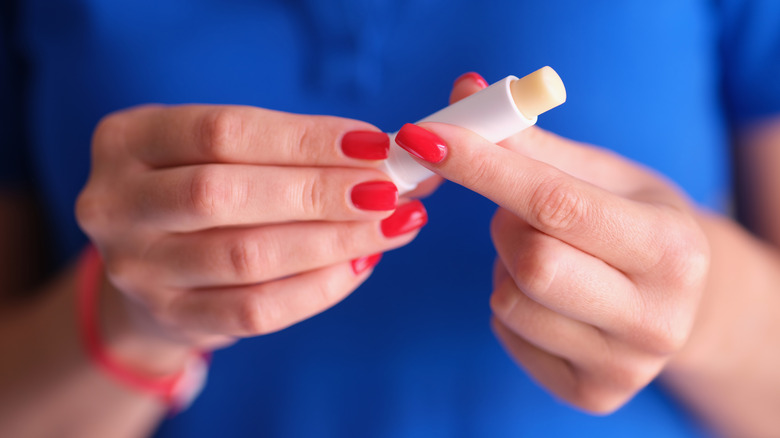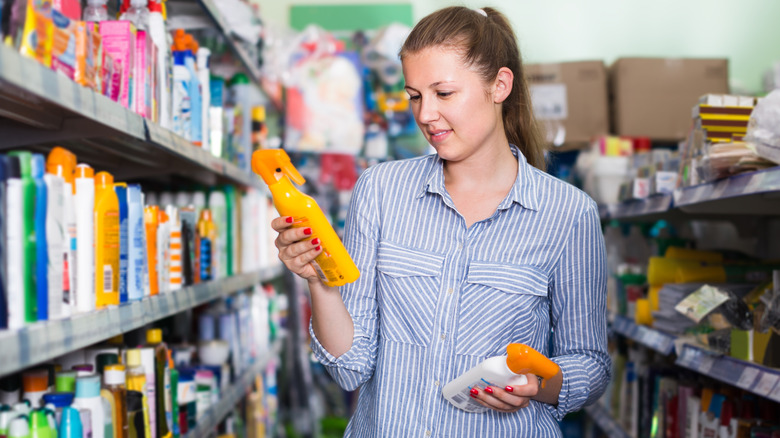How Much Of A Sunscreen Stick Do You Need To Use For Full Effectiveness?
Broad-spectrum sunscreen comes in many different forms, eliminating any excuse to go without SPF protection while under the sun. Whether you prefer mineral sunscreen or the kind that comes in a spray can, using it can dramatically reduce your risk of getting burned by ultraviolet (UV) rays. Additionally, you'll also be limiting signs of premature aging, such as wrinkles, and your chance of developing skin cancer by wearing it. That being said, some people are unsure of the ins and outs of sunscreen — how often does it need to be applied? What SPF should you be looking for when you purchase sunscreen? How much do you need to use for sufficient protection?
If you're applying sunscreen that comes as a cream or lotion, it's a bit easier to determine if you're covered — simply follow the white streaks on your body as you apply it to see where you need to use more. When you're using a formula that comes in a different form, however, it can be a little more challenging. A sunscreen stick, for example, may leave you feeling like you can't possibly use too much. Any type of sun protectant that goes on invisible can make it even harder to tell if you're wearing enough.
As it turns out, going back over the same area with a sunscreen stick is typically necessary to get full SPF protection — and doing this a few times may even be needed.
How to get the most protection from a sunscreen stick
Sunscreen sticks have changed the game for those of us who want a quick, easy way to re-apply sunscreen throughout the day without lugging around a bottle or can. They're compact, meaning they can easily be thrown into a tote or gym bag and used on the go. However, it's important to know that if you want the full effect of the product, most of them need to be re-applied over the same area. The instructions that come with the specific item you're using will tell you exactly how it should be done. However, most sunscreen sticks need to be swiped over the same area of the body a handful of times for adequate coverage. "Then make sure to rub it in," board-certified dermatologist Dr. Christina Lee Chung told The Zoe Report. "It can be your primary form of SPF sun protection, but I personally apply and recommend my patients do a first coat of sunscreen with a thick layer of lotion or a cream."
If you aren't confident in gauging how much of an invisible formula you've applied, you may want to go back to a white, streaky formula that fades with time. It might be unsightly, but doing so can give you the peace of mind you're looking for when applying sunscreen for protection. Massaging the sunscreen into your skin afterward is also necessary if you want to make sure you're protected and minimize any streaks.
What to know about using any type of sunscreen
There's no doubt that the sun can do an ample amount of damage to your skin, in addition to raising your risk of skin cancer. For this reason, the U.S. Food & Drug Administration recommends using broad-spectrum sunscreens — those that protect you from both UVA and UVB rays — that have at least an SPF 15 rating. However, no amount of sunscreen is going to protect you if it isn't applied correctly.
While invisible formulas are best for avoiding unsightly streaks, going with a visible formula may actually be necessary if you're guilty of under-applying sunscreen. This can help you make sure you're getting the coverage you want, whether you're using a sunscreen stick, lotion, or spray. If you're using a sunscreen stick, the American Academy of Dermatology Association (AAD) says it's best to go over the areas you're applying it four times, and then rub it in. "Sticks are easy for under the eyes and the backs of the hands, while spray sunscreens are often easier to apply on children," board-certified dermatologist Debra Wattenberg explained to the AAD.
The convenience of sunscreen sticks can make them tempting to use over lotions and sprays, especially if you want to skip the mess. Some sun protection is certainly better than no sun protection, but it's important to be mindful of these key differences.


